Mobile GPU Faceoff: AMD Dynamic Switchable Graphics vs. NVIDIA Optimus Technology
by Jarred Walton on September 20, 2011 6:40 AM ESTWhat about Recent Games?
We do have one major concern with AMD’s Dynamic Switchable Graphics that we haven’t really addressed so far: drivers. Why are drivers a problem? Just like AMD’s non-dynamic switchable graphics, you’re stuck waiting for your laptop OEM to release new drivers, as AMD’s mobile reference drivers are only for discrete GPUs (and even then, not all OEMs participate, Sony and Toshiba being two prime examples). The drivers for switchable graphics consist of a proxy driver that intercepts calls and determines which GPU should receive the request, Intel’s IGP driver, and AMD’s GPU driver. AMD informed us that they make a new driver build available on a monthly basis for switchable graphics, but it’s up to the laptop vendors to test and validate the driver (and add in their hooks for keyboard shortcuts like LCD brightness and such) and make it available to the public. Generally speaking, this happens when a laptop is first launched, and if you’re lucky, you might get one or two more driver updates before the OEM stops worrying about an older model laptop.
So how big of a concern is this really? Our selection of gaming benchmarks consists of games that are all six months to more than a year old, so any moderately recent driver should work properly on our test suite. As we’ve already noted, there was a periodic stability issue in DiRT 2 (not consistently reproducible and perhaps related more to the game than AMD’s drivers), and there was a major rendering issue in StarCraft II at medium detail settings or higher. With our current gaming suite experiencing problems, we wanted to look at some newer titles to see if the drivers might have additional issues.
We selected six games that have all come out in the past six months. In alphabetical order, the games are Deus Ex: Human Revolution, DiRT 3, Duke Nukem Forever, Portal 2, Super Street Fighter IV: Arcade Edition, and The Witcher 2—and we’re also tossing in results from Enemy Territory: Quake Wars just for fun (an OpenGL game). Some of these games will become part of our new benchmark suite in a couple months (after Battlefield 3, Rage, and Skyrim launch) while others are recent releases that ought to be moderately demanding. We did run performance tests on all of these games, along with testing for compatibility with the Sony and Acer laptops. First, let’s look at performance, using Medium settings.
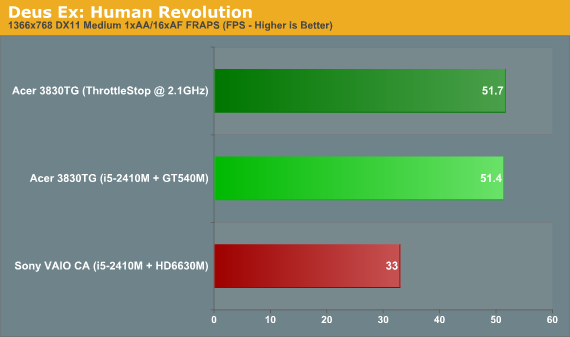
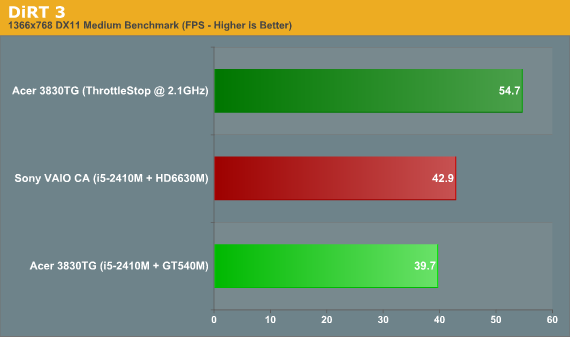
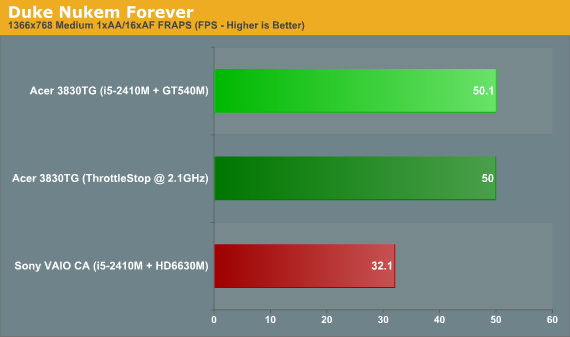
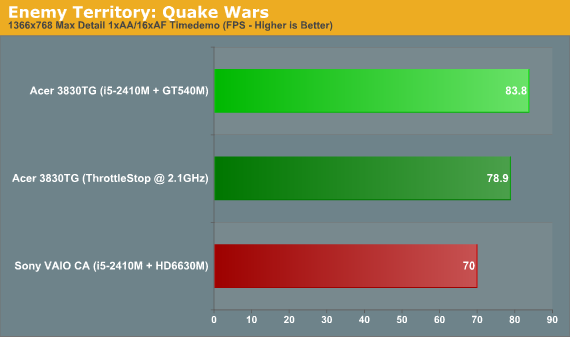
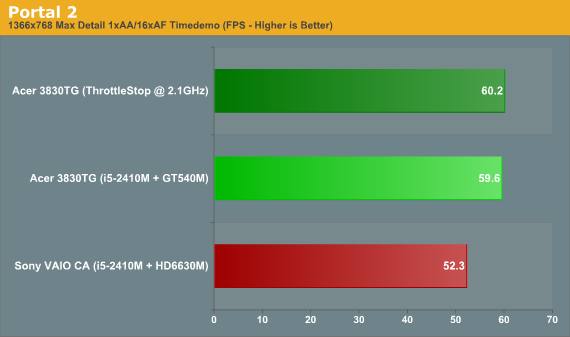
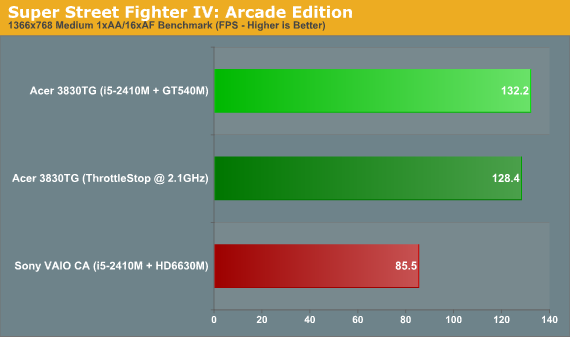
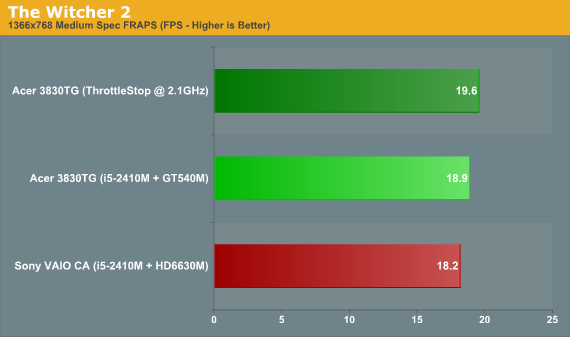
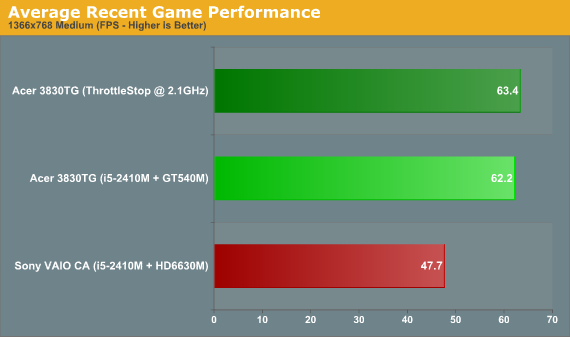
So here’s where things get interesting. In our current (soon to be deprecated) list of games on the previous page, the 6630M in the VAIO C generally equals the GT 540M in the Acer 3830TG. NVIDIA wins in Bad Company 2, Left 4 Dead 2, Mafia II, Mass Effect 2, and STALKER: Call of Pripyat by 4-14%; AMD counters by claiming wins in Civilization V (3%), DiRT 2 (1%), Metro 2033 (6%), StarCraft II (31%), and Total War: Shogun 2 (6%). Obviously, StarCraft II is the big difference, and it looks like the CPU throttling (or using ThrottleStop to set the CPU speed to 2.1GHz) accounts for a large portion of the difference. As we mentioned on the previous page, the Alienware M11x R3 averages out to 3.5% faster than the best the Acer can muster, and the Dell XPS 15 comes in 9% faster than the 3830TG, so if the CPU throttling weren’t present we’d expect the 3830TG to end up around 6% faster than the VAIO CA. Be that as it may, let’s just call it a tie between the GT 540M and HD 6630M and move on to our newer titles.
Looking at the recent releases (along with the OpenGL Enemy Territory: Quake Wars), the tables shift dramatically. The closest the VAIO C/HD 6630M gets is in The Witcher 2, where the Acer 3830TG/GT 540M still has an 8% lead. Elsewhere, NVIDIA leads by over 50% in Deus Ex: Human Revolution, Duke Nukem Forever, and Super Street Fighter IV: Arcade Edition. Rounding things out, DiRT 3 is 28% faster, ETQW is a 20% lead, and Portal 2 is 15% faster. Also worth pointing out is that three of the games in this list (DiRT 3, Deus Ex, and Portal 2) are promoted by AMD (and SSF4 is promoted by NVIDIA). Overall, in our recent titles the Acer leads the Sony by a not-insignificant 35% on average—and that’s with an Optimus laptop that we’re either running at a slower CPU speed, or potentially getting some CPU throttling. How much of the performance loss is caused by unoptimized drivers is unclear, but we suspect the 6630M with Catalyst 11.8 would fare a lot better.










91 Comments
View All Comments
Death666Angel - Wednesday, September 21, 2011 - link
"but then why even have dynamic switching in the first place?"That is a good question. I myself would prefer a solution that lets me decide what to do. I wouldn't prefer dynamic switching, because I want to be in control of my hardware as much as possible. Reboot switching is of course a pain in the butt, but I see nothing wrong with a short cut manual switch for iGPU/dGPU switching. Would be preferable to me actually.
But otherwise, thanks for the article.
mars2k - Wednesday, September 21, 2011 - link
I purchased a Lenovo W520 on the first day of release. Got the Thinkpad and could never get the graphics to perform correctly. Integration with the Intel board was lousy. Lenovo's support team could do nothing. I returned the machine. I'm thinking buggy drivers were the problem.My particular problem revolved around using multiple monitors. Connecting disconnecting or configuring multi monitors would often require a reboot. Worse than worthless!
Wolfpup - Wednesday, September 21, 2011 - link
“With all my talk of switchable graphics, though, let’s make one thing clear: switchable graphics is not necessarily the Holy Grail of mobile GPUs. The true ideal in my opinion is mobile GPUs that can run fast when needed (i.e. playing games), while also being able to power off large portions of the chip and RAM and get down to IGP levels of power consumption.”THANK you for that! That's the first time I've heard that said since all this switchable graphics stuff started.
As far as I'm concerned, the GPU situation on notebooks is a disaster, and right when I thought we were finally moving in the first direction, this switchable stuff came out.
As it is now, a HUGE percent of notebooks can't use Nvidia or AMD's normal drivers. Sandy Bridge + AMD shouldn't even be on the market, and shouldn't be considered by anyone. As the article mentions-you can't use normal drivers for those, at least not today. (AMD + AMD should work sooner or later, although the A series CPUs aren't listed yet in the driver download box on AMD.com...my little c50 notebook is supported though, so hopefully the A stuff will be soon too.)
I just bought Asus' G74, which I've really liked-and one of the reasons I bought it was that it DOESN'T use switchable graphics, and it DOES use normal drivers from Nvidia. Some more expensive systems with even better GPUs can't use the normal drivers, which IMO just isn't acceptable in a $1000 purchase, let alone a $2000+ purchase.
At any rate, Nvidia's current GPUs underclock themselves to a very impressive 50mhz, several times slower even than my Geforce 9650GT from 3 years back. As mentioned, get power gating in there, and just get rid of Optimus and AMD's equivalent. Get rid of that complexity, driver/compatibility weirdness, etc.
Even once switchable graphics are gone, we're STILL not there yet...as the article mentions, most of Sony and Toshiba's notebooks can't be updated. Sager's stuff apparently can't, etc.
My Asus N80 from 3 years ago and my G74 both accept Nvidia.com driver updates just like a desktop system, no hacks, nothing weird, it just works. And that's how it should be!
Anato - Friday, September 23, 2011 - link
Shouldn't be too difficult to make GPU which can divide resources so that parts of the unit can be shut down. Even CPU's can do that and they are executing same code as compared to GPU which can be more liberal on architecture.JonnyDough - Friday, September 23, 2011 - link
"If nothing else, Sony at least knows how to tune their laptops for long battery life."Now if they can just make PS3 networking that isn't so hackable, batteries that don't explode, and Blu-Ray discs that don't cost 4X as much as an up-scalable DVD. At least they are smart enough to partner up with AMD.
pman6 - Friday, September 23, 2011 - link
AMD's solution definitely seems half assed. Their drivers are always crap....just like how they rolled out the mobile llano hybrid crossfire with crap performance.
seems like they can never get the drivers right.
I have a llano laptop with crossfire, and you would think they would be able to do split frame rendering to improve performance. but 99% of the time, crossfire game performance is worse than discrete alone.
AMD needs to get their crap together.
netkcid - Friday, September 23, 2011 - link
good job trying to switch and run dx11 apps on a dx10 igp... and then complain about it...durJarredWalton - Saturday, September 24, 2011 - link
All of the games should run on the Intel IGP; none of them are DX11 only. Double dur. The point is that they're not switching over to the IGP when the laptop is set to do so. But that's not really the major issue -- if you're running a game, you'll want it on the dGPU 99% of the time. The real issue is that the dynamic switching failed to work properly. When the competition can make it work properly, and when your non-dynamic generally can work properly, then your drivers are not finished and certainly not worthy of WHQL certification (which has apparently become a joke these days).medi01 - Sunday, September 25, 2011 - link
"Before we get to the actual meat of this review, we have a disclaimer to make: both laptops we’re comparing came to us via NVIDIA. Now, before anyone cries “foul!”, let me explain..."Let me explain: AMD not sending you whatever you want is not a good enough reason to do hidden ads for nVidia.
JarredWalton - Tuesday, September 27, 2011 - link
Thanks for speaking for AMD, but I talked to them over four times throughout the course of this review. I've had this hardware since July, if that helps you figure out how much I've been waiting for AMD to step up with something better. In effect, I told AMD when I first got the laptop, "Look guys, I've got a Sony VAIO C with Intel + AMD dynamic switchable graphics, and there are problems. There are also no recent drivers. This review won't be favorable toward your solution if you can't get me something better." If I had given them a week, or even two, sure, but two months is more than enough time to give me something better if such a thing exists.Sticking up for AMD's solution just because it's from AMD is not a reason enough to do so. The solution as it currently stands is broken. It can be fixed, but until it actually IS fixed, I cannot recommend buying it. Like I said, I'd rather have AMD discrete GPU without switchable graphics on a laptop, because then at least I can get driver updates. And if you don't need driver updates, you don't really need a discrete GPU in your laptop.